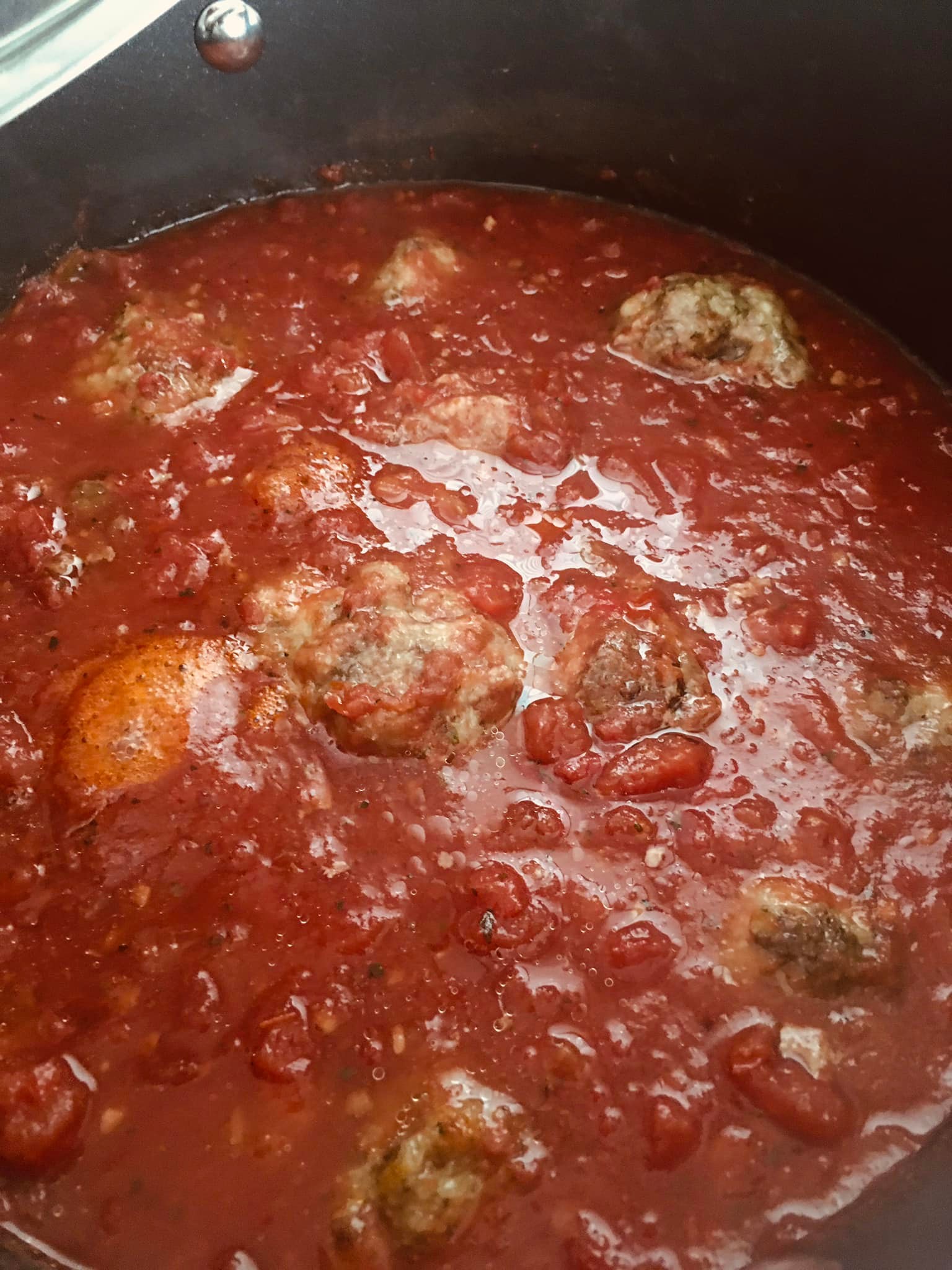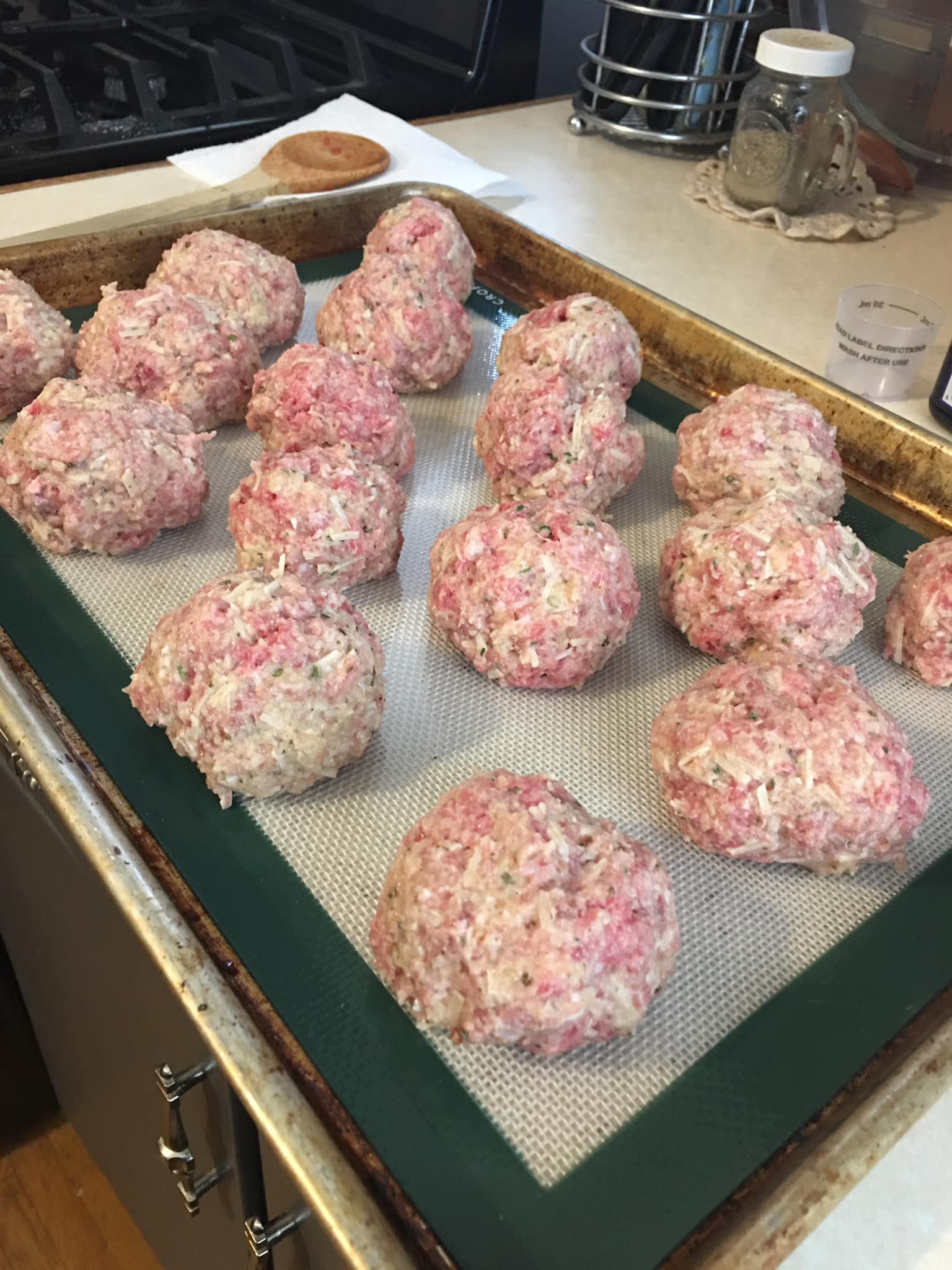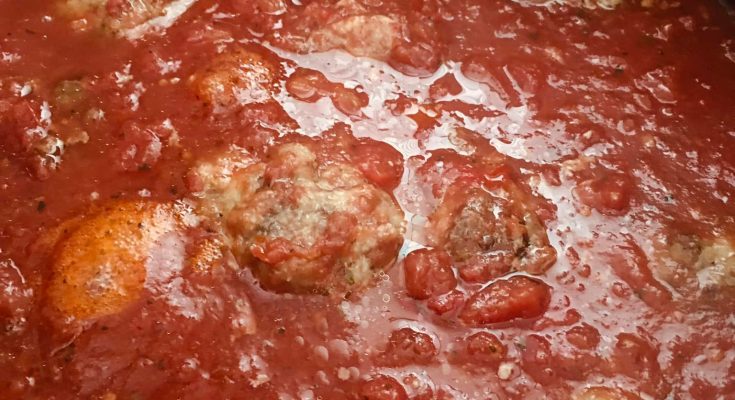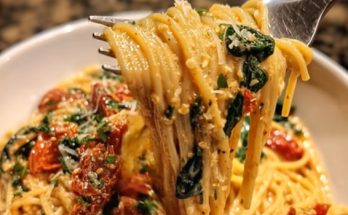Few dishes embody the soul of Italian home cooking like classic Italian meatballs simmered in rich tomato sauce. Each bite tells a story of comfort, patience, and the simple beauty of fresh ingredients coming together in harmony.
Tender meatballs made from a trio of beef, pork, and veal deliver the perfect balance of flavor and texture — hearty yet delicate, rich yet melt-in-your-mouth soft. The buttermilk-soaked breadcrumbs infuse the mixture with moisture, while freshly grated Parmigiano-Reggiano adds a nutty depth and a hint of salty warmth.
Simmered gently in a fragrant homemade tomato sauce, each meatball absorbs layers of tangy, garlicky goodness that make this dish irresistibly comforting. Whether served over twirls of spaghetti, nestled in a toasted sub roll, or enjoyed simply with crusty bread, this recipe is a timeless reminder of why Italian food feels like a warm hug from the kitchen.

Why People Will Love Italian Meatballs with Homemade Sauce Recipe
Authentic Italian Comfort: Each meatball carries the warmth and soul of classic Italian home cooking — slow-simmered, deeply flavored, and irresistibly comforting.
Perfect Texture Balance: The combination of beef, pork, and veal creates a tender, juicy interior with just the right amount of richness and structure.
Homemade Goodness: The sauce isn’t just a background — it’s a star in its own right, infused with garlic, herbs, and slow-cooked tomatoes that cling beautifully to every bite.
Rich Yet Light: Thanks to buttermilk and breadcrumbs, the meatballs stay moist and delicate without feeling heavy, offering a refined take on a rustic favorite.
Versatile and Heartwarming: Whether served with spaghetti, crusty bread, or enjoyed on their own, these meatballs transform any meal into a comforting, restaurant-worthy experience at home.
Key Ingredients:
Ground Beef, Pork, and Veal: The traditional Italian trifecta — beef provides body, pork adds richness and depth, and veal lends a delicate tenderness for that melt-in-your-mouth texture.
Buttermilk and Breadcrumbs: This creamy, tangy pairing keeps the meatballs incredibly moist and soft, while binding everything together without making them dense.
Parmigiano-Reggiano: Aged and nutty, this cheese infuses the mixture with deep umami flavor and a subtle salty balance that defines authentic Italian meatballs.
Fresh Garlic and Herbs: Garlic, parsley, basil, and oregano layer each bite with aromatic warmth and true Mediterranean character.
Homemade Tomato Sauce: Slow-simmered with onions, garlic, and crushed tomatoes, the sauce becomes rich and velvety — the perfect companion for soaking and finishing the meatballs.
Expert Tips:
Use a Gentle Touch: When mixing the meatball ingredients, handle the mixture lightly. Overmixing compacts the proteins, resulting in tough, dense meatballs instead of soft, tender ones.
Let the Binder Rest: After combining the breadcrumbs, eggs, buttermilk, and cheese, let it sit for at least 10 minutes. This allows the breadcrumbs to fully absorb the liquid, creating a moist and uniform texture once mixed with the meat.
Chill Before Shaping (Optional): If your mixture feels too soft or sticky, refrigerate it for 15–20 minutes before forming the meatballs. This helps them hold their shape during baking and simmering.
Bake Before Simmering: Baking the meatballs at 375°F (190°C) helps them develop a flavorful crust and hold together better when transferred to the sauce — without falling apart.
Simmer, Don’t Boil: When cooking the meatballs in the sauce, keep the heat at a gentle simmer. A rolling boil can break them apart and toughen the meat. Slow simmering allows the sauce and meat to meld beautifully.
Layer the Flavor: Add a pinch of sugar to your tomato sauce to balance acidity and bring out the natural sweetness of the tomatoes. A drizzle of olive oil at the end enhances richness.
Finish with Cheese and Fresh Herbs: Just before serving, sprinkle freshly grated Parmigiano-Reggiano and chopped basil or parsley over the top for a restaurant-quality finish bursting with aroma and depth.

Italian Meatballs with Homemade Sauce
Ingredients
For the Meatballs
¾ lb ground beef
¾ lb ground pork
½ lb ground veal
1 cup Italian-style breadcrumbs
2 large eggs, lightly beaten
1 cup buttermilk
1 cup freshly grated Parmigiano-Reggiano
Salt and black pepper, to taste
Optional: chopped onion, parsley, or Italian herbs (basil, oregano) for extra flavor
For the Sauce
Use your favorite homemade tomato sauce, or simmer a simple one with:
2 tablespoons olive oil
1 small onion, finely diced
4 cloves garlic, minced
1 (28 oz) can crushed tomatoes
1 teaspoon salt
1 teaspoon sugar
1 teaspoon dried basil
½ teaspoon black pepper
Instructions
1. Prepare the Meat Mixture
In a large bowl (Bowl 1), combine the ground beef, pork, and veal.
Mix gently with your hands or a spoon—just enough to combine without compacting the meat.
2. Prepare the Binder
In another bowl (Bowl 2), stir together the breadcrumbs, eggs, buttermilk, and grated Parmigiano-Reggiano.
Add optional herbs or minced onion if you like.
Let the mixture rest for 10 minutes so the breadcrumbs fully absorb the liquid.
3. Combine
Add the breadcrumb mixture to the meat and mix gently until just combined.
Avoid overmixing to keep the meatballs tender.
4. Shape and Bake
Preheat your oven to 375°F (190°C).
Shape the mixture into large meatballs (about the size of a golf ball or slightly larger).
Arrange on a baking sheet lined with parchment paper or lightly greased foil.
Bake for 25 minutes, until browned and nearly cooked through.
5. Simmer in Sauce
While the meatballs bake, prepare or heat your tomato sauce in a large pot over medium-low heat.
Transfer the baked meatballs directly into the simmering sauce.
Cover and let them cook for another 20–30 minutes, allowing them to soak up the sauce and finish cooking through.
To Serve
Serve hot with spaghetti, fresh basil, and extra Parmigiano-Reggiano on top.
Pairs beautifully with garlic bread and a crisp salad.
Chef’s Notes
For extra tenderness, use fresh breadcrumbs instead of dry.
The buttermilk helps keep the meatballs light and moist.
A mix of beef, pork, and veal gives a classic Italian flavor balance—beef for structure, pork for richness, and veal for delicate texture.
Important Notes When Making Italian Meatballs with Homemade Sauce
The Meat Ratio Matters: The classic Italian blend of beef, pork, and veal isn’t random — each plays a specific role. Beef provides structure, pork adds juiciness and richness, and veal contributes tenderness. If you can’t find veal, replace it with extra pork for similar texture and flavor balance.
Fresh Ingredients Elevate Flavor: Use freshly grated Parmigiano-Reggiano instead of pre-shredded cheese — it melts better and adds a nutty depth. Likewise, freshly minced garlic and herbs will make the sauce more aromatic than dried or jarred versions.
Don’t Skip the Buttermilk: Buttermilk isn’t just a liquid binder — its mild acidity tenderizes the meat and keeps the texture light. If unavailable, mix 1 tablespoon of lemon juice or vinegar with 1 cup of milk as a substitute.
Control Moisture Carefully: The breadcrumb mixture (bowl 2) should be moist but not soggy. Too much liquid can cause the meatballs to fall apart, while too little will make them dry. Adjust with a few extra breadcrumbs if needed.
Consistency is Key: Shape the meatballs evenly so they cook uniformly. Uneven sizes can result in some being undercooked while others dry out.
Sauce Absorption Is Crucial: Once transferred to the sauce, the meatballs should simmer gently. This final step lets them absorb the tomato base and release their savory juices, creating a perfectly balanced, rich flavor.
Rest Before Serving: After simmering, allow the meatballs to sit in the sauce for 5–10 minutes off the heat. This helps the flavors meld and the texture set, making them even more succulent when served.
How to Enjoy Italian Meatballs with Homemade Sauce:
Let the Flavors Settle:
Once the meatballs finish simmering in the sauce, allow them to rest for about 5–10 minutes off the heat. This pause helps the sauce thicken slightly and allows the meatballs to reabsorb the savory juices they released during cooking — resulting in a richer, more cohesive bite.
Pair with the Perfect Base:
Serve the meatballs over freshly cooked pasta such as spaghetti, fettuccine, or rigatoni. Toss the pasta lightly with a bit of the tomato sauce before plating, so every strand is coated in flavor. Alternatively, enjoy them with creamy polenta, mashed potatoes, or even crusty Italian bread to soak up the sauce.
Finish with Layers of Freshness:
Sprinkle each serving with extra grated Parmigiano-Reggiano and torn fresh basil leaves. A light drizzle of good-quality olive oil enhances the aroma and adds a silky finish to the dish.
Create a Complete Italian Experience:
Balance the richness of the meatballs with a crisp green salad dressed in lemon and olive oil or pair with roasted vegetables for a lighter touch. Garlic bread or a warm baguette makes the perfect companion to mop up every drop of sauce.
Wine Pairing for Depth:
A glass of medium-bodied red wine like Chianti, Montepulciano, or Sangiovese pairs beautifully with the tomato-based sauce and the hearty meat. The acidity of the wine cuts through the richness and elevates the meal.
Serve Family-Style:
Place the pot of saucy meatballs in the center of the table and let everyone serve themselves. The sight of glossy meatballs nestled in deep red sauce invites warmth and conversation — the true spirit of Italian dining.
Next-Day Enjoyment:
The flavors deepen overnight, making leftovers even better. Reheat gently over low heat or in the oven, covered, to keep the meatballs tender. Serve them on toasted sub rolls with melted mozzarella for an irresistible Italian meatball sandwich.
Nutrition Information
(per serving — approximately 2 large meatballs with sauce):
Calories: 365 kcal | Total Fat: 22.8 g | Saturated Fat: 8.7 g | Monounsaturated Fat: 9.1 g | Polyunsaturated Fat: 1.3 g | Cholesterol: 115 mg | Sodium: 560 mg (depending on added salt and sauce) | Total Carbohydrates: 11.4 g | Dietary Fiber: 1.9 g | Sugars: 3.2 g | Protein: 29.6 g
Frequently Asked Questions:
What makes using three types of meat (beef, pork, and veal) better than using just one?
The combination of meats creates perfect balance — beef adds structure, pork brings richness and fat for flavor, and veal provides tenderness. Using all three results in moist, melt-in-your-mouth meatballs that stay flavorful even after simmering in sauce.
Can I make these meatballs ahead of time?
Yes! You can shape and refrigerate the raw meatballs up to 24 hours in advance or freeze them for up to 3 months. When ready to use, thaw overnight in the fridge and bake as directed before simmering in sauce.
Why bake the meatballs before simmering them in sauce?
Baking helps render out some fat, giving the meatballs a light crust that seals in moisture. Finishing them in sauce infuses flavor and keeps the texture soft and tender — the best of both worlds.
What’s the secret to keeping the meatballs tender and not dense?
Avoid overmixing. Combine the ingredients just until incorporated, and let the breadcrumb mixture soak for at least 10 minutes before mixing. This ensures moisture is evenly absorbed, creating a delicate, airy texture.
How can I serve these meatballs for a restaurant-quality presentation?
Serve over al dente spaghetti, ladled with sauce, sprinkled with freshly grated Parmigiano-Reggiano, and finished with a drizzle of good olive oil. Pair with garlic bread and a glass of red wine for an elevated Italian dining experience.
How do I keep the meatballs from falling apart while cooking?
Make sure your binder (breadcrumbs, eggs, and buttermilk) is fully soaked before mixing with the meat. This ensures a cohesive texture that holds together during baking and simmering without becoming dense.
Can I fry the meatballs instead of baking them?
Yes, pan-frying is a classic alternative. Brown the meatballs in a large skillet with olive oil over medium heat until all sides are golden. Then, transfer them to the sauce to finish cooking. This adds an extra layer of flavor from the seared crust.
What can I use instead of buttermilk?
If you don’t have buttermilk, mix 1 cup of milk with 1 tablespoon of lemon juice or white vinegar. Let it sit for 5 minutes — it will curdle slightly, creating the same tenderizing effect as buttermilk.
How can I make the sauce richer and more flavorful?
Simmer the sauce slowly and allow the meatballs to cook in it for at least 20–30 minutes. This deepens the flavor, while the meat juices naturally enrich the sauce. You can also add a splash of red wine or a bit of tomato paste for extra depth.
Can I make this recipe gluten-free?
Absolutely. Use gluten-free breadcrumbs and double-check that your buttermilk and cheese are gluten-free certified. The texture and flavor remain nearly identical, especially if you keep the balance of moisture in the mix.



